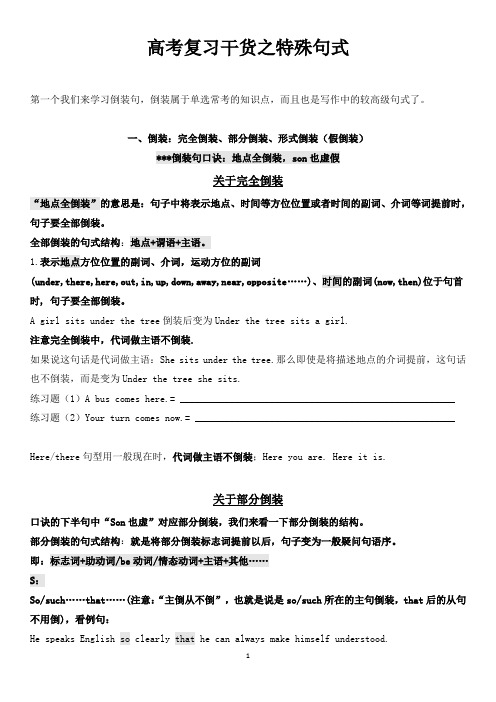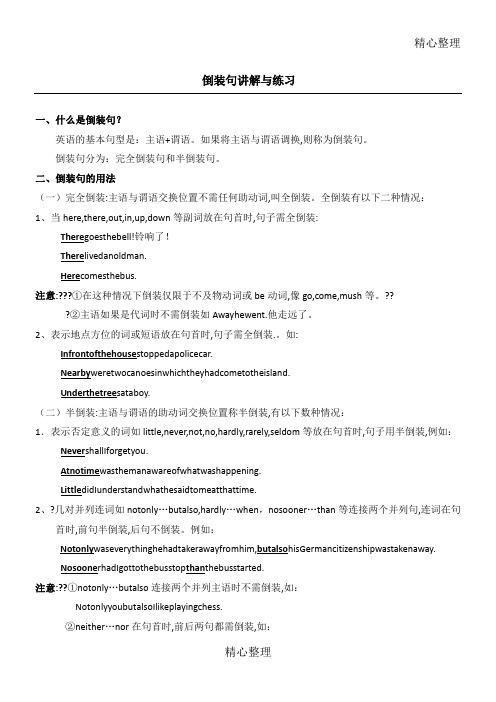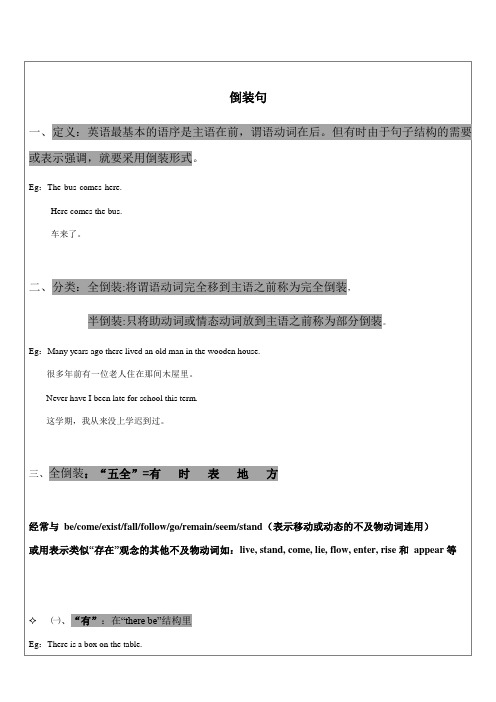高中英语倒装句型讲解与练习(3)
- 格式:docx
- 大小:21.88 KB
- 文档页数:4

第一个我们来学习倒装句,倒装属于单选常考的知识点,而且也是写作中的较高级句式了。
一、倒装:完全倒装、部分倒装、形式倒装(假倒装)***倒装句口诀:地点全倒装,son也虚假关于完全倒装“地点全倒装”的意思是:句子中将表示地点、时间等方位位置或者时间的副词、介词等词提前时,句子要全部倒装。
全部倒装的句式结构:地点+谓语+主语。
1.表示地点方位位置的副词、介词,运动方位的副词(under,there,here,out,in,up,down,away,near,opposite……)、时间的副词(now,then)位于句首时, 句子要全部倒装。
A girl sits under the tree倒装后变为Under the tree sits a girl.注意完全倒装中,代词做主语不倒装.如果说这句话是代词做主语:She sits under the tree.那么即使是将描述地点的介词提前,这句话也不倒装,而是变为Under the tree she sits.练习题(1)A bus comes here.= _______________________________________________________ 练习题(2)Your turn comes now.= ____________________________________________________Here/there句型用一般现在时,代词做主语不倒装;Here you are. Here it is.关于部分倒装口诀的下半句中“S on也虚”对应部分倒装,我们来看一下部分倒装的结构。
部分倒装的句式结构:就是将部分倒装标志词提前以后,句子变为一般疑问句语序。
即:标志词+助动词/be动词/情态动词+主语+其他……S:So/such……that……(注意:“主倒从不倒”,也就是说是so/such所在的主句倒装,that后的从句不用倒),看例句:He speaks English so clearly that he can always make himself understood.=so是标志词,所以so clearly这个意群提前(举个例子来说意群:一辆出租车来了=来了一辆出租车,其中“一辆出租车”这几个字不能拆分,它就是一个意群),然后再将主句调整为上边说的部分倒装句式结构。

高中英语倒装句倒装句分为全部倒装和部分倒装1全部倒装全部倒装是只将句子中的谓语动词全部置于主语之前。
此结构通常只用于一般现在时和一般过去时。
常见的结构有:1)here, there, now, then, thus等副词置于句首, 谓语动词常用be, come, go, lie, run等表示来去或状态的动词。
例如:Then came the chairman. 那时总裁来了。
Here is your letter. 你的信。
2). up,down,out,away,in , off, ahead放于句首Up jumped the cat and caught the mouse.Ahead sat an old woman.3)表示地点,时间,方向等的介词短语放在句首时例如:After the head walked a group of workers.4.“作表语的现在分词/过去分词/形容词+系动词+主语”形式的完全倒装Seated in the front were the guests.注意:上述全部倒装的句型结构的主语必须是名词,如果主语是人称代词则不能完全倒装。
例如:Here he comes. 他来了。
Away they went. 他们走开了。
2部分倒装部分倒装是指将谓语的一部分如助动词或情态倒装至主语之前。
如果句子的谓语没有助动词或情态动词,则需添加助动词do, does或did,并将其置于主语之前。
1. 句首为否定或半否定的词语,如no, not, never, seldom, little, hardly, rarely, scarely, in no way, under no circumstance, at no time决不, not until… 等。
例如:Never have I seen such a performance. 从未见过如此糟糕的表演。
Nowhere will you find the answer to this question. 无论如何你不会找到这个问题的答案的。

高中英语倒装句倒装句分为全部倒装和部分倒装1 全部倒装全部倒装是只将句子中的谓语动词全部置于主语之前。
此结构通常只用于一般现在时和一般过去时。
常见的结构有:1)here, there, now, then, thus等副词置于句首 , 谓语动词常用 be, come, go, lie, run等表示来去或状态的动词。
例如:Then came the chairman. 那时总裁来了。
Here is your letter. 你的信。
2). up,down,out,away, in , off, ahead 放于句首 Up jumped the cat and caught the mouse.Ahead sat an old woman.3)表示地点,时间,方向等的介词短语放在句首时例如:After the head walked a group of workers.4.“作表语的现在分词 /过去分词 /形容词 +系动词 +主语”形式的完全倒装Seated in the front were the guests.注意:上述全部倒装的句型结构的主语必须是名词,如果主语是人称代词则不能完全倒装。
例如:Here he comes. 他来了。
Away they went. 他们走开了。
2 部分倒装部分倒装是指将谓语的一部分如助动词或情态倒装至主语之前。
如果句子的谓语没有助动词或情态动词,则需添加助动词 do, does或 did,并将其置于主语之前。
1. 句首为否定或半否定的词语,如 no, not, never, seldom, little, hardly, rarely, scarely, in no way, under no circumstance, at no time决不 , not until 等⋯。
例如:Never have I seen such a performance从.未见过如此糟糕的表演。

倒装句:“NAOSHI” 原则一、什么是倒装:有时由于句子结构的需要或表示强调或方便上下文衔接,要采用倒装形式。
主+ 谓------------- 自然语序谓+ 主------------- 完全倒装助动词/系动词/情态动词+ 主+ 谓------------- 部分倒装(半倒装)强调部分+ as + 主+ 谓------------- 形式倒装举例:1. The bus is coming here!倒装:Here comes the bus! (名词作主语)2. Our school lies north of the river.倒装:North of the river lies our school.二、“闹事N A O S H I”原则详解:N: 助动词/系动词/情态动词+ 主语+ 谓语(半倒装)1. 否定副词置于句首,句子部分倒装,( 如never, nor, not, hardly, hardly...when, no sooner...than, little, seldom, scarcely, rarely等)Hardly do I think you will make it.Not until midnight did it stop raining.Not only should we not be afraid of difficulties, but we should try our best to overcome them.2. 表示否定意义的短语置于句首,部分倒装,( 如at no time, under/in no circumstances, in no case, by no means,on no condition 等)By no means should you tell him about it. 你绝不要告诉他这事。
A : 形式倒装(前置)As/though引导的让步状语从句:只把强调的内容提到句首,主谓不用变化。

精心整理倒装句讲解与练习一、什么是倒装句?英语的基本句型是:主语+谓语。
如果将主语与谓语调换,则称为倒装句。
倒装句分为:完全倒装句和半倒装句。
二、倒装句的用法1注意212、?时,前句半倒装,后句不倒装。
例如:Notonly waseverythinghehadtakerawayfromhim,butalso hisGermancitizenshipwastakenaway.Nosoone rhadIgottothebusstop than thebusstarted.注意:??①notonly…butalso连接两个并列主语时不需倒装,如:NotonlyyoubutalsoIlikeplayingchess.②neither…nor在句首时,前后两句都需倒装,如:Neither doIhaveasister nor doesmyhusband.3、only放在句首强调状语时,主句用半倒装。
例如:Onlythen didIrealizethatIwaswrong.Onlyinthisway canIlearnfrommyfault.Onlywhenthewarwasoverin1918washeabletogetbacktowork.注意:only强调主语不倒装:如Onlytheteacherscanusetheroom.4、so…that句型,so放在句首时,主句用倒装结构,that从句不用倒装。
例如:5.倒装句练习题1.HismotherhadtalkedtohimformanyminuteswhilehewaswatchingTV,but____.A.alittledidhehear??B.littledidhehear??C.littleheardhe??D.alittleheardhe2.——Hello,ZhuHua.I’llhavetoreturntoCanadabecauseI’veworkedhereforayear. ——_____!A.Whattimeflies??B.Howtimeflies??C.Whatdoestimefly??D.Howdoestimefly3.Duringthewar,____butalsohelosthiswifeandhischild.4.6.10.——Whatsportdoyoulikebest?——Springboarddiving(跳板跳水).___todiveintowaterfromhighboard!A.Whatafunisit??B.Howfunitis??C.Howafunisit??D.Whatfunitis11.——Theoldmanwouldn’tstayathomeforarestevenifitrained.——____.Hewouldfeelsickifhestayedhomeforoneday.A.Sowouldmygrandpa???B.Sowouldn’tmygrandpaC.Neitherwouldmygrandpa??????D.Norwouldn’tmygrandpa12.___forustosurf(冲浪)ontheseainsummer!A.Whatexcitingisit??B.Howexcitingisit?C.Whatexcitingitis??D.Howexcitingitis13.Bynomeans___toourplanforthetrip.A.willsheagree??B.shewillagree??C.agreesshe??D.willagreeshe14.Thechildtiptoed(翘起脚尖走)quietlytothebird.___intotheforestwhenhewasabouttocatchit.A.Flewitaway??B.Awayflewit??C.Awayitflew??D.Flewawayit16.18.21.A.liesaverydeepvalley??B.doesaverydeepvalleylieC.averydeepvalleylies??D.averydeepvalleylays23.Theywentintoasmallhousebut___.A.nopersonsdidtheyfind????????B.notapersonfoundtheyC.notapersondidtheyfind???????D.notapersontheyfound24.——Mymotherdoesalotofhouseworkbeforegoingtowork,butshehasneverbeenlate.——_____.A.Sodoesmymother?B.Neitherdoesmymother?C.Norhasmymother?D.Soitiswithmymother25.Everyonehasarrivedateightand____.A.thendoesthemeetingbegin??B.thenbeginsthemeetingC.beginsthemeetingthen???????D.doesthemeetingbeginthen26.__itisforustoseethathedoeshisworksowell!28.30.33.MothertoldRosetobuysomesugarinthesupermarketand___.A.shedidso????B.soshedid??????C.sodidshe???????D.shedidsuch34.___shortlyafteritstoppedraining.A.Thereappearedacolorfulrainbowinthesky?B.IntheskydidacolorfulrainbowappearC.Thereacolorfulrainbowappearedinthesky?D.Thereintheskyacolorfulrainbowappeared35.Afterthepatientswentintotheoffice,__working.A.onlyadoctordidtheysee???B.onlyadoctorsawtheyC.onlyadoctortheysaw???????D.onlyadoctorhadtheyseen36.Wehavelookedforthelostsheepalmosteverywhere,butnowhere_____.A.wecanfindit???B.canwefindit???C.canfindweit???D.wecanitfind37.Onlysincetheygaveupthatgoodchance___toshowtheirinventionagain.39.40.A.sodoI????B.sowillI???C.nordoI???D.norwillI44.Sinceeveryonehascomebackhere,___.A.ongoesourdiscussion?????B.goesonourdiscussionC.ondoesourdiscussiongo??D.doesonourdiscussiongo45.__whenwepassedbyitsnest.A.Upintotheblueskydidthebirdfly?????B.UpintotheblueskythebirdflewC.Upintotheblueskyflewthebird????????D.Flewupintotheblueskythebird参考答案及讲解1.B。

桌子上面有一个盒子。
✧㈡、“时”:表示时间副词,如:now,then,
Eg:Now comes your turn.
现在轮到你了。
✧㈢、“表”:表语放句子前,“表语+系动词+主语” 的结构
Eg:Present at the party were Mr. Green and many other guests.
格林先生和其他的客人在这个聚会上。
Seated on the ground are a group of young men.
一群年轻人坐在了地上。
✧㈣、“地”:地点状语放在句首
Eg:In south of the river lies a small factory.
小工厂位于河的南方。
From the valley came a cry.
山谷传来一阵哭声。
✧㈤、“方”:表方位的副词here, there 或out, in, up, down, away, off 等标志词放在句首 Eg:There lies a large wheat field in front of the house.
房子前面有一大片麦田。
Off all the lights went when I came in.
当我进来时,所有的灯都灭了。
四、半倒装:“八部”=不只让步也常需(虚)如此祝福✧㈠、“不”表示否定。
高中英语语法倒装句讲解与练习含答案全部倒装1.here,there,out ,in,up,down,now,then,away,over,off等副词位于句首时,后面句子用全部倒装。
(1)There goes the bell.(2)Here comes the bus. (3)Now comes my turn.(4)Then followed three day of rain.注意:主语是代词时,不用此倒装结构(5)Out rushed the children.=The children rushed out.(Out they rushed主语为代词时句子不倒装).(6)In came the teacher and the lesson began.=The teacher came in and the lesson began.In he came and the lesson began.主语为代词时句子不倒装2.表语和地点状语位于句首表示强调意义时,后面用全部倒装,当表示时间的副词或介词词组位于句首时,常常引起全部倒装,注意:主谓一致。
(1)In the distance was a small boat=A small boat was in the distance.(2)Under a big tree sat an old man smoking a pipe.=An old man smoking a pipe sat under a big tree.(3)They arrived at a farm house ,in front of which sat a small boy.(4)On either side were rows of fruit trees.(5)Early in the morning came the news .3.在一些表示祝愿的句子中Long live China.部分倒装1.only修饰句子的状语位于句首时,后面引起部分倒装。
倒装句讲解及练习全部倒装全部倒装是指整个谓语放到主语的前面,即谓语在前,主语在后。
有下列几种:1.there be (lie, stand, live...)句型。
there be是谓语,其后的名词是主语。
E.g. There are different forms of energy.2.在以here, there, out, in, up, down, away,now,then等开头的句子中。
E.g. There goes the bell.Here comes the bus.Out rushed the boy.Away went the children.主语是人称代词时不倒装。
例如:E.g. Here it is.给你。
Away he went.他走了。
3.当句首状语为表地点的介词词组时,也常常引起全部倒装。
E.g. From the valley came a frightening sound.South of the city lies a big steel factory.4.表语置于句首时,倒装结构为“表语+系动词+主语”(1)形容词+系动词+主语E.g. Present at the meeting were Professor White and many other guests.(2)过去分词+系动词+主语E.g. Gone are the days when they could do what they liked to the Chinese people.(3)介词短语+be+主语E.g. Among the goods are Christmas trees, flowers, candles and toys.5.such置于句首时E.g. Such was Albert Einstein, a simple man and the 20th century’s greatest scientist.此句型中的such多被认为是表语,所以such后面的be动词应该与其后的“真正主语”保持一致。
Grammar of the Inversion (Module 5 Unit 4)倒装句英语最基本的语序是主语在前, 谓语动词在后。
但有时由于句子结构的需要或表示强调, 就要采用倒装形式。
倒装分两种情况: 1)将谓语动词完全移到主语之前称为完全倒装, 2)只将助动词或情态动词放到主语之前称为部分倒装。
并且强调性倒装和以so, neither, nor开头的句子是高考例题的热点。
一、倒装句的意义1.用倒装构成疑问句,适应一定的语法结构的需要。
.in?Was the People's Liberation Army founded in 1927?2.为了强调某一部分, 而把这部分放到句首, 构成倒装。
t.fo.schoo.thi.term.So early did he come to school that no other students came.二、倒装的用法完全倒装1.在“ther.be”结构里, there是引导词, 主语在be后。
在“there + be”结构中的谓语动词有时不用be , 而用表示类似“存在”观念的其他不及物动词。
如: live, stand, come, lie, flow, enter, rise 和appear等。
e.g.Ther.i..bo.o.th.table.There came shouts for help from the river.There lies a large wheat field in front of the house.Many years ago there lived an old man in the wooden house.2.为了表达生动, 有时把表地点、方位的副词, 如here, there, now , then,, thus ,up, down, out, off, over, away, in等放在句首, 同时把谓语动词放在主语之前, 在here, there等副词开头的某些句子里(要用一般现在时态)。
初中英语倒装句(一)倒装句的意义1、适应一定的语法结构的需要,主要是指疑问句句型结构的需要。
E.g. Was the People’s Liberation Army founded in 1927?2、为了强调某一部分,而把这部分放到句首,构成倒装。
e.g. Never have I been late for school this term.(二)倒装的使用情况一、部分倒装:就是把谓语中的be动词、助动词或情态动词置于主语前面。
常见于下列几种情况:(一). only所修饰的副词,介词短语或状语从句放在句首时,要用:only+ 状语+ be /助动词/情态动词+主语及其他例如:Only when he told me the news did I know what had happened.注意:only修饰主语时,不需要倒装。
例如:Among all the people, only you know the truth.小试牛刀:Only in this way ________to make improvement in the operating system.A. you can hope???B. you did hope???C. can you hope???D. did you hope(二).含有否定意义的副词或连词放在句首时。
如:never, little, seldom, not, not only, not until, nosooner (…than), hardly (…when), rarely, scarcely, in no wa y等。
(三)例如:We seldom get up at four in the morning.= Seldom do we get up at four in the morning.(四) Not a single word from him could express his feelings.(五)(1) hardly…when; scarcely…when…; no sooner…than… 可以用正常语序had hardly done when… did 或用倒装句式Hardly had + 主语+ done when… did 句式。
倒装(教师版)英语句子的自然顺序是主语在前,谓语在后。
但是如果把谓语动词放在主语之前,就叫倒装结构。
一•如果全部谓语放在主语之前,叫全部倒装;二•如果只把助动词或be动词放在主语之前就叫部分倒装。
三如果只把强调的内容提至句首,主谓并不倒装,这样的结构叫做形式倒 _______ .下面就以上三种倒装进行讲解并练习。
一.全部倒装:1. a)用于there be句型。
There are many students in the classroom. 主语位于谓语are 之后。
原句自然顺序是:Many stude nts are there in the classroom..There are differe nt forms of en ergy.b)在“ there + be结构中的谓语动词有时不用be ,而用表示类似存在”观念的其他不及物动词。
如: live, stand, come, lie, flow, enter, rise 和appear 等。
There came shouts for help from the river.There lies a large wheat field in front of the house.Many years ago there lived an old man in the woode n house.2. 用于(here ,there, now, then , such) +不及物动词+主语"的句型中。
a. Here comes the bus.b. There goes the bell.c. Now comes our turn.d. Out went the children.e. Such are his words.f. Such is the story.3. 以out, in, up, down, away, ahead,over 等副词开头的句子里面,表示强调。
In came the teacher.Out rushed a missile from un der the bomber.轰炸机肚底下窜出一枚导弹。
Ahead sat an old woma n.即时练习:1) Here comes an excellent stewardess。
来了位优秀的女乘务员。
2) Down went the expert. 专家下来了。
3) Out rushed the enthusiastic painter. 热情的画家冲了出去。
4) _______ and caught the mouse.A. Up the cat jumpedB. The cat up jumpedC. Up jumped the catD. Jumped up the cat 5) Over ______ , dead.6) _____________________________ The door ope ned and there .A. en ters an old manB. en tered an old manC. did an old man en terD. an old man en tered注意:代词作主语时,主谓语序不变。
Here it is. In he comes.即时练习:1) Away he went 他出去了。
2)In she came 她进来了。
3) ____________________________________ .—Where is my shirt, mum? —.A. There is itB. There it isC. There isD. Here is it4) . —Where is your father? —Oh, ________ .A. here he comesB. he here comesC. here does he comeD. here comes he3. 当句首状语是表示地点的介词词组时,也常引起全部倒装。
请观察以下句子:To the south of the city lies a big steel factory.From the valley came a frighte ning sound.Under the tree stands a little boy.总结:划线的均是表示地点状语,位于句首。
即时练习:1) Under a big tree _______ , half asleep.A. did sat a fat manB. a fat man satC. did a fat man satD. sat a fat man2) ______ play ing soldiers.A. In side the room were two boysB. In side the room two boysC. Were two boys in side the roomD. I nside the room was two boys4. 有时,句子的主语较长,或是为了强调表语和状语,常将他们放在句首,同时颠倒主语和谓语的位置,使句子平衡。
请观察以下句子:(1) 介词+连系动词+主语Among the goods are Christmas trees, flowers, can dles and toys.(2) 形容词+连系动词+主语Prese nt at the meeti ng were Professor White, Professor Smith and many other guests.(3) 过去分词+连系动词+主语Gone are the days whe n they could do what they liked.(4) 表示方位的状语+谓语+主语They arrived at a farmhouse, in front of which sat a small boy.A. rolling the goatB. rolled the goatC. did the goat rollD. the goat rolled即时练习:1) . ______ who was woun ded in the stomach.A. Among them were a soldierB. Among them was a soldierC. Among them a soldier wasD. Among they was a soldier2) Prese nt at the meet ing were Preside nt Liu, Professor Zhang and others.出席会议的人有刘主席,张教 授和其他人。
3) Gone forever are the days when we Chinese were pressed 。
中国人受压迫的日子已经一去不复返了。
4) They arrived at the space station , in side which stood a robot.他们到达了太空站里面站在个机器人。
二:部分倒装1. 用于疑问句。
Do you speak En glish?但是疑问句中,如果疑问词作主语或主语的修饰语,主谓不倒装。
What happe ned to her ?她出了什么事?How many people are working in that laboratory ?有多少人在那间实验室里工作?h) Not only the stude nts but also the teacher ___________________A. does go to the partyB. goes to the party.C. go to the partyD.do go to the party2.1) 用于 n ever, hardly, seldom, scarcely, little, rarely, no where, at no time, bt no means , in no way,in no case , on no con diti on, on no acco unt, not only 等否定词开头的句子里。
A. had he begu n B. bega n heC. did he beg inD. does he begi n3)用于only 开头的句子(only 位于句首,修饰副词、介词短语或状语从句 )。
和not …until 的句型中,部分倒装。
观察以下两组句子:(3) Seldom does he eat breakfast.(4) Not only did he speak English correctly , but also he speaks it fluently请比较 Not only men but also women and children are affected by the new law.-Only when he told me did I realize what trouble he was in. talsO nly in this way can you learnEnglish well. Only the winners have the opport un ity to face the challe nges.语不总结:如果置于句首的由only 引导的词组不是状语,而是主语,则主谓不倒装。
即时练习:2) 用于 No sooner had done sth …than… did …,Hardly /scarcely had 短语表示 一 .... 就”之意) 和not …until•的句型中。
No sooner had she gone out than the class began. Not until the teacher came did he finish his homework.即时练习:On ly after he bega n to work could he realize the power of the teacher ______ 只有当他开始工作时他才能意识到老师话语的力量。
On ly en thusiastic employees can be fit for such a tough job 只有热情的雇员能胜任这样一份艰苦的工作。